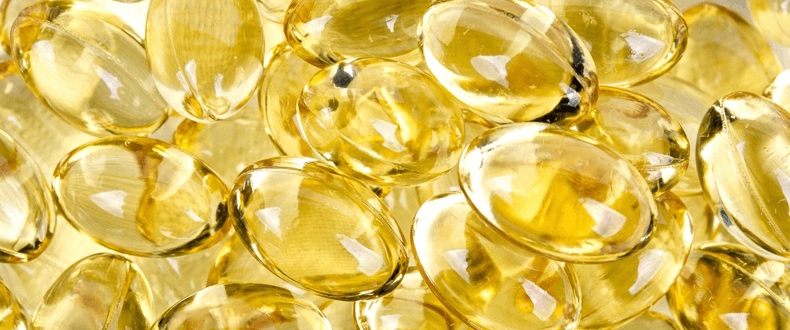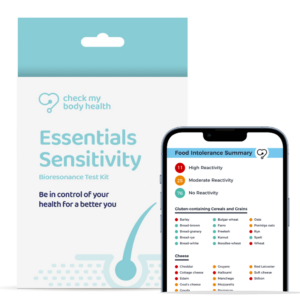Too Much Vitamin D? | Vitamin D Overdose

Medically reviewed by Gareth James, GP, GMC, DRCOG, DFFP, MRCGP on March 31, 2023. To give you technically accurate, evidence-based information, content published on the Check My Body Health blog is reviewed by credentialed professionals with expertise in medical and bioscience fields.

Taking too high a dose of Vitamin supplements for too long can lead to an excessive build up of vitamin D in your body known as hypervitaminosis D. You cannot develop hypervitaminosis D from having too much sun exposure, nor from your diet. Although rare, this condition can present with such symptoms including nausea, vomiting, loss of appetite, constipation, weakness, and weight loss.
High levels of vitamin D may also cause a rise in calcium levels in the blood (hypercalcemia). This can lead to more startling symptoms such as extreme weakness, confusion, and disorientation.
Some experts postulate that these raised levels of calcium may also cause the build-up of calcium in soft tissues, such as the heart, kidney and blood vessels, which can cause damage to these organs. A blood test is required to make a diagnosis of a Vitamin D toxicity.
What can be done about vitamin D toxicity?
Stop taking any Vitamin D supplements, and re-evaluate your Vitamin D levels some 3 months later. It is always best to speak with a nutritionist before starting any supplement regimen, as they can recommend you the proper dosage according to your specific needs.
What is vitamin D toxicity
Vitamin D toxicity, also known as hypervitaminosis D, is a condition that occurs when a person has excessive levels of vitamin D in their body. This can lead to an excessive amount of calcium in the blood, which can cause damage to the kidneys, bones, and other organs. Symptoms of vitamin D toxicity include nausea, vomiting, weakness, frequent urination, and kidney damage. In severe cases, it can lead to coma or death. It usually happen when people take excessive supplement of Vitamin D regularly.
Monitoring kidney function
Hospitalization may be necessary for severe cases or cases with complications.
It’s important to consult with a healthcare professional to determine the best course of treatment, as the specific treatment plan will depend on the individual’s case.
If you suspect you may have vitamin D toxicity, it is important to contact a healthcare professional right away. High levels of vitamin D can cause serious health problems if left untreated.
Signs and symptoms of too much vitamin D
The signs and symptoms of too much vitamin D, also known as hypervitaminosis D, can include:
- Nausea and vomiting
- Loss of appetite
- Constipation
- Weakness and fatigue
- Confusion and disorientation
- Frequent urination
- Itchy skin
- Kidney damage, which can lead to the formation of kidney stones and abnormalities in kidney function
- High blood pressure
- Calcium deposits in soft tissues such as the heart, lungs, and blood vessels
- Excessive thirst
- Headaches
These symptoms can occur gradually and may not be immediately obvious. In severe cases, vitamin D toxicity can lead to coma or death.
It’s very important to have a proper diagnose from doctor and not self-diagnose.
How much vitamin D do you need?
The amount of vitamin D that a person needs can vary depending on their age, sex, and overall health. The recommended dietary allowances (RDAs) for vitamin D are as follows:
Infants aged 0–12 months: 400–1,000 international units (IU) per day
Children aged 1–18 years: 600–4,000 IU per day
Adults aged 19–70 years: 600–4,000 IU per day
Adults aged 71 years and older: 800–4,000 IU per day
Pregnant and breastfeeding women: 600–4,000 IU per day
It’s important to note that these are just general recommendations and that individuals should consult with their healthcare provider to determine their specific needs. Vitamin D needs can also be affected by factors such as sunlight exposure, skin pigmentation, and the use of certain medications. Also, It’s not good to exceed the upper limits (UL) which are set at 4,000 IU per day for adults and children over the age of 9.
It’s always important to check the label of supplements and consult with a healthcare professional before taking any supplement.
Best Ways to get vitamin D
Vitamin D is known as the ‘Sunshine Vitamin’ with 90% of vitamin D production resulting from sun exposure. This is because the body produces its own vitamin D when the skin is exposed to ultraviolet B (UVB) rays from the sun. The amount of vitamin D the body produces from sunlight exposure depends on several factors, including the time of day, the season, latitude, and the person’s skin pigmentation.
Exposure to the sun between the hours of 10 a.m. and 3 p.m., during the spring and summer month is the best time. Expose the face and forearms (so sleeves up) for 10 to 15 mins a day (15 to 25 mins if dark pigmented skin) even if overcast.
Daily exposure of these months should build enough levels of Vitamin D to see you through the darker winter months. But remember to enjoy the sun safely, as any sun burning could increase your future chance of developing skin cancer.
Production of Vitamin D will drop by 95% if you use greater than factor 15 sunscreen, only apply your sunscreen after your Vitamin D exposure time has been reached. Daily exposure of these months should build enough levels of Vitamin D to see you through the darker winter months.
Vitamin D deficiency
Vitamin D deficiency usually occurs due to lack of exposure to the sun. This therefore common in those who do not go outside (such as the housebound), those who live in countries like the UK where there is less sun exposure and those from Black or South Asian communities with darker pigmented skin more likely to suffer.
Although small, you can obtain a degree of your required Vitamin D from your diet.
Food sources of vitamin D include:
- fatty fish, such as salmon, tuna, and mackerel
- fish liver oils
- beef liver
- cheese
- egg yolks
- mushrooms
In the UK there are also foods that have been fortified with extra Vitamin D, such as dairy products, orange juice, soy milk and breakfast breakfast cereals, fat spreads (margarine), plant-based drinks, yoghurts, plus dried and evaporated milks.
For people who have low sun exposure or risk of deficiency, a dietary supplement can be a good option especially over the winter months. 10 micrograms a day is the recommended amount according to NHS guidelines for a typical adult. It’s important to check with a healthcare professional before starting taking any supplements, as they may interact with other medications or have side effects. It’s also important to follow the instructions on the label and not exceed the recommended dosage.
It’s good to keep in mind that although vitamin D is important for health, it’s also possible to get too much, which can be harmful.
Signs of inadequate vitamin D intake
Roughly 1 in 6 of the UK population have insufficient Vitamin D levels, probably the most common Vitamin deficiency in the UK.
The majority of individuals do not experience any symptoms of a Vitamin D insufficiency
A vitamin D blood test is the only way to diagnose a deficiency.
Some individuals though do experience symptoms of an inadequate vitamin D intake, those these symptoms can be subtle and may not appear right away. Some signs of vitamin D deficiency include:
- Fatigue and tiredness
- Bone and back pain
- Weakness and muscle pain
- Impaired wound healing
- Increased susceptibility to infections
- Depression
- Hair loss
- Bone weakness or softness and an increased risk of fractures
- Delayed wound healing
Children with inadequate vitamin D intake may develop the following signs:
- Rickets, which is a condition that causes the bones to soften and become misshapen
- Delayed growth and development
- Tooth decay
It’s important to note that these symptoms can also be caused by other medical conditions, and that a definitive diagnosis of vitamin D deficiency requires a blood test.
It’s also worth mentioning that In some cases, people may not show any symptoms but still have a vitamin D deficiency.
Benefits of testing your vitamin D levels
Testing your vitamin D levels can provide important information about your overall health and help identify deficiencies. Some benefits of testing vitamin D levels include:
Identifying deficiencies early: Testing can detect low levels of vitamin D before symptoms develop, allowing for early intervention and reducing the risk of long-term health problems.
Monitoring treatment: If you have been diagnosed with a deficiency, testing can be used to monitor your response to treatment and ensure that your vitamin D levels are in the appropriate range.
Assessing risk: Testing can help determine your risk for vitamin D deficiency, which can be influenced by factors such as age, skin pigmentation, and sunlight exposure.
Identifying other health problems: Low levels of vitamin D have been linked to a number of health conditions, such as osteoporosis, diabetes, heart disease, and some types of cancer. Testing can help identify these conditions early and allow for early intervention.
Proper dosing: Dosing of vitamin D supplements is highly individual and dependent on the level of Vitamin D as identified through a blood test. Thus, the test results can help the healthcare professional to recommend the appropriate dosage.
It’s always important to consult with a healthcare professional to determine if testing is appropriate for you and how often you should be tested. Generally, testing is recommended for people who are at risk for deficiency, such as older adults, people with darker skin, and people who do not get much sunlight exposure.
References
- What is vitamin D toxicity? Should I be worried about taking supplements?. Mayo Clinic. Accessed September 18, 2020. (https://www.mayoclinic.org/healthy-lifestyle/nutrition-and-healthy-eating/expert-answers/vitamin-d-toxicity/faq-20058108)
- Vitamin D. National Institutes of Health. Accessed September 18, 2020. (https://ods.od.nih.gov/factsheets/VitaminD-HealthProfessional/)
- Taking too much vitamin D can cloud its benefits and create health risks. Harvard Medical School. Accessed September 18, 2020. (https://www.health.harvard.edu/staying-healthy/taking-too-much-vitamin-d-can-cloud-its-benefits-and-create-health-risks)
- Vitamin D. NIH, Office of Dietary Supplements. Accessed September 18, 2020. (https://ods.od.nih.gov/factsheets/VitaminD-HealthProfessional/)



